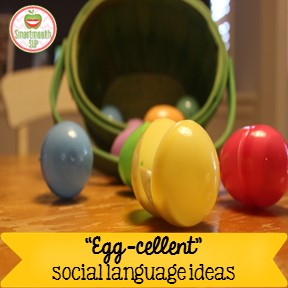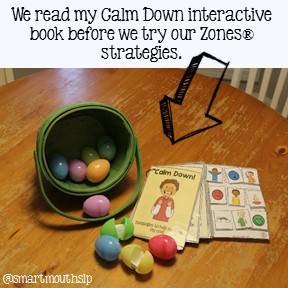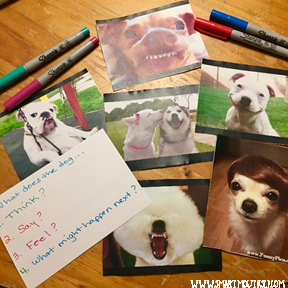
picture by Eric Britz
We are in the midst of Spring break (yay) and Easter is right around the corner. I have been seeing lots of posts about targeting articulation and language using plastic eggs, so I thought I would add my two cents on ways to work on social language! The colored eggs are perfect to work on Zones of Regulation ® with my students too. The red(pink), yellow, blue and green eggs align to each zone, but just as there are no wrong emotions, there are no wrong colors either, so if you have a few orange, teal or white eggs, no worries. Ask your students to come up with what emotions they think might align with these colors. Don’t be surprised at how creative and insightful they can be!
We also prep by reviewing books or videos as a refresher to what each zone might look like. I made an interactive book, Calm Down, that I use with my younger elementary friends as part of this prep. We can then brainstorm ways to calm ourselves down when we are in the red, yellow or even blue zones. My students can dictate or write down these strategies on pieces of paper and put them into the corresponding colored eggs.

You can put different strategies in any colored egg and have your students choose one, read the strategy and then match it to the zone. For your students who are comfortable and accurate with these concepts, you can extend this into a “good egg/bad egg” game and have the kids decide if the strategy in the egg is a good solution/expected one or an unexpected strategy. For example, if you are in a red zone (angry, furious, out of control) and the strategy says to go take a walk and calm down, that’s an expected solution. However, if the strategy says to scream in someone’s face until you feel better, that’s definitely an unexpected solution. How fun would it be to put the “good eggs” in a basket, and the “bad eggs” in a little trashcan? You can further tease out the social language concepts of consequences and how other people might feel or think about us when we have unexpected reactions.
Have you seen those cute emoji eggs in the dollar stores? Me too, but if you can’t find them, just make your own with a sharpie! You can draw different mouths on both sides of the bottom of the shell, different eye and eyebrows on the top of the shell and rotate to get more choices per egg. You can give your students the chance to draw their own egg emojis and have their peers guess which emotion they drew and identify the clues they used to make those guesses. Hello non-verbals! If you give them an emotion, ask your students to identify scenarios that might elicit that emotion (write or draw a picture) and stuff them in the eggs.
You can also fill the eggs with tiny objects or picture clues that all relate to one concept or idea. For example, a tiny cake, a candle, a ribbon, a deflated balloon=birthday party! This is a fun way to work on gestalt thinking and help our kids connect the details to the big picture ideas. The quicker or the less clues they need to make a smart guess, the more “points” they earn (it doesn’t have to be a tangible reinforcer, my kids are competitive enough to just want to beat the previous number of guesses)! I don’t deduct points for a wrong guess, but we do stop and talk about what made them make that guess, and it gives me insight to where the breakdown might be.
Lastly, you can use the eggs and a basket to work on conversation skills. Each person gets two of the same colored eggs (one gets blue, one gets green, etc..). I write a CC (connecting comment) or a ? (ask a question) on all of the eggs indicating what the student needs to add, and I tape a picture of the topic on a basket. We go around the table until all the eggs are in the basket and we have maintained the topic so that everyone has asked a related question and made a connecting comment. I’ll play too and throw in an off topic comment or ask a totally unrelated question to see if my kids catch me!
I hope you found some egg-cellent ideas to work on social language concepts with your students this Spring! What are some other ways you use plastic eggs?





